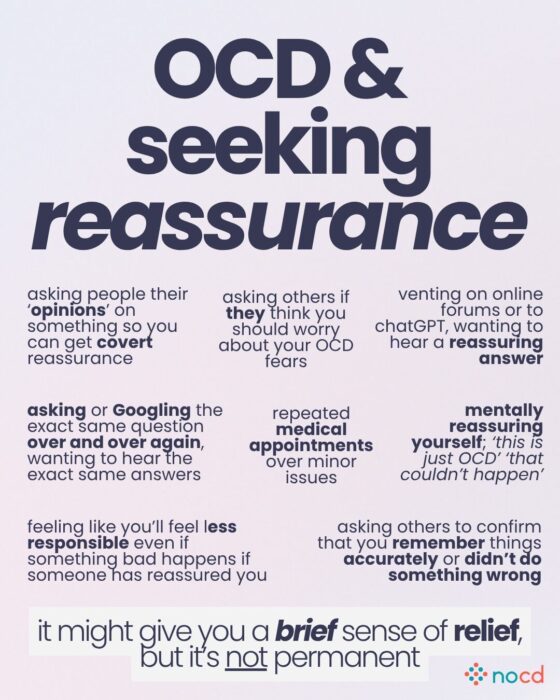Everyone wants reassurance from time to time, but with obsessive-compulsive disorder (OCD), that desire can become persistent and overwhelming. Reassurance seeking is a compulsion that can be treated effectively with exposure and response prevention (ERP) therapy.
We all need—and provide—reassurance from time to time. Perhaps you’ve helped a little kid after they’ve fallen off a bike by brushing them off and telling them it will be okay. Maybe you’ve found yourself comforting a friend after a breakup by listing all the reasons that their life still has meaning. Or, maybe you’ve asked a loved one for validation or support to ease temporary doubts or insecurities.
According to Dr. McGrath, Chief Clinical Officer at NOCD, “reassurance is an everyday part of social interaction.” In some cases, however, reassurance seeking can become excessive. If you find yourself frequently asking friends, family members, or romantic partners for validation, and still feel unsatisfied, you may be seeking reassurance as a compulsion—a common symptom of obsessive-compulsive disorder (OCD).
Read on to learn more about excessive reassurance seeking, how you can spot this behavior, and how to get support.
Is it normal to want reassurance?
Reassurance can take the form of verbal and/or non-verbal interactions, and typically serves to help lessen concerns, anxieties, or doubts. You may engage in reassurance seeking to increase your perceived sense of certainty, or to try to feel safe from potential harm.
Most people feel a need for reassurance in situations that provoke fear, guilt, anxiety, stress, and other negative emotions. “These tend to be unpleasant feelings, so we usually want to get rid of them,” Dr. McGrath explains. “Reassurance often helps, at least in the short term, but it’s not always effective.”
If you’re experiencing grief, for example, you may seek reassurance out of a desire to feel better—but, simply hearing “this too shall pass” likely won’t alleviate all of your negative emotions. Reassurance, like most things we do, isn’t completely good or bad. It’s a common behavior that is a component of many social interactions. In some situations, however, it can be an indication of a mental health condition—like OCD.
Find the right OCD therapist for you
All our therapists are licensed and trained in exposure and response prevention therapy (ERP), the gold standard treatment for OCD.
How does reassurance seeking show up in OCD?
Most people seek reassurance from time to time, but won’t feel a persistent need to ask for it. If the need for validation and affirmation starts to become constant, however, it may be a sign of an underlying mental health issue. While reassurance seeking is associated with a number of mental health conditions, including depression, it is especially common in people dealing with OCD.
OCD is a complex mental health condition characterized by two primary symptoms: obsessions and compulsions. Obsessions are intrusive, persistent thoughts, feelings, urges, images, and sensations that cause significant anxiety or distress. In response to this distress, people with OCD engage in compulsions—repetitive mental or physical acts meant to alleviate negative feelings, or prevent a bad thing from happening.
Reassurance seeking is a common OCD compulsion. Similar to compulsive checking, people with OCD may seek reassurance in an attempt to relieve doubts or concerns. Unlike checking, however, reassurance seeking transfers the responsibility onto another person, by asking them to assuage fears, or confirm that you’ve done nothing wrong.
Why do people with OCD seek reassurance?
Since researchers haven’t found a definitive cause for OCD, we don’t know exactly why the brain causes OCD obsessions to emerge—or why people respond with compulsions. From a psychological perspective, however, we know that OCD compulsions, like reassurance seeking, are a way to try to navigate negative emotions like anxiety, distress, and uncertainty. “If you feel unsure about something, you might try to get someone else to tell you that things will work out just fine,” Dr. McGrath explains.
When you ask for reassurance, you’re looking for someone else to neutralize your distress. “It feels like a big relief, but in the long-term it guarantees that you won’t learn how to tolerate uncertainty,” Dr. McGrath says. Instead, you’ll find yourself searching for reassurance every time you feel unsure, which will only reinforce the idea that you can’t handle these emotions on your own.
The problem with excessive reassurance seeking
Every time you engage in a compulsion, you teach your brain that you need to do that ritual in order to feel safe. But, any feelings of safety you gain from compulsively seeking reassurance are always temporary. “It might help for a little bit, but the urge tends to return quickly,” Dr. McGrath says. “As a result, people with OCD tend to ask for reassurance more often, with more urgency, and they may feel unable to proceed without it.” The distinguishing factor for people with OCD isn’t that they seek reassurance; it’s that their reassurance seeking behaviors get out of their control quickly, and don’t provide long-term relief.
Like other compulsions, reassurance-seeking works by negative reinforcement: Because it briefly gets rid of an unpleasant feeling, the compulsive behavior is strengthened. “The result? We just want more and more reassurance,” Dr. McGraths says. He says research suggests that reassurance seeking makes intrusive thoughts worse, because the compulsion supports the idea that your fears are so scary, you need other people to help you handle them. In other words, reassurance seeking fuels the OCD cycle.
Community discussions
How to stop seeking reassurance
If you’re engaging in reassurance seeking as a compulsion, it’s likely you want to stop. As with all compulsions, reassurance seeking can be time-consuming and exhausting—but, it can also end up alienating the people around you. After all, it can be hard for loved ones to know how to respond to this behavior. As a result, you may find yourself withdrawing from family and friends. Luckily, it is possible to learn how to resist seeking reassurance.
Exposure and response prevention (ERP) therapy
If you’re living with OCD, your most important tool for managing reassurance seeking will be exposure and response prevention (ERP) therapy, a specialized form of cognitive behavioral therapy (CBT) that is designed to help reduce OCD symptoms. ERP is the best way to unlearn reassurance seeking behaviors, because it teaches you how to resist compulsions. This form of therapy works by gradually exposing you to situations that trigger fear, or anxiety, and training you in response prevention techniques—so you learn new ways to cope with challenging emotions.
ERP therapists are experts in understanding OCD intrusive thoughts and compulsive behaviors—and creating personalized programs that can help you slowly start to confront these thoughts in new ways. For example, let’s imagine you experience persistent fears that your romantic partner is going to leave you. In response, you frequently ask them for reassurance that the relationship is going well, or that they love you. You may even have developed a routine where you seek reassurance at regular intervals throughout the day: upon waking, after returning home from work, and before going to bed.
Your ERP therapist might begin your work together by asking you to delay your compulsion. Instead of asking for reassurance immediately upon waking, you might set a timer for an hour, forcing yourself to sit with uncertainty for a little bit longer than usual. Over time, your therapist would work with you to extend these delays, until you’ve proved to yourself that you don’t need to seek reassurance to allow negative feelings to pass.
ERP is highly successful, because it disrupts the OCD cycle at the point of compulsions, demonstrating that you can survive your difficult feelings and thoughts without deferring to these behaviors—and making these fears feel less scary, in turn.
Reassurance seeking vs. support seeking
While ERP therapy is the most effective way to treat OCD symptoms, like reassurance seeking, Dr. McGrath says people who rely on this compulsion can also consider learning more about the concept of support seeking. Reassurance seeking can be a dangerous compulsion, but everyone can benefit from a little support sometimes. Let’s explore what it means to seek support vs. reassurance.
The difference between reassurance seeking and support seeking is subtle, but lies in the motivation behind the behavior. Dr. McGrath says remembering the chain of events that triggers reassurance seeking is key for distinguishing these behaviors.
Reassurance seeking is an attempt to get rid of the distress by getting rid of the uncertainty that underlies it.
Dr. Patrick McGrath
“Support seeking, however, means allowing the uncertainty and distress to exist, while also acknowledging that it’s easier to succeed with the support of others,” he adds.
Let’s consider an example: Imagine you’ve just started ERP therapy. While ERP is highly effective, it’s also not an overnight cure for OCD—and ERP exercises can be highly challenging, especially at first. Reassurance seeking here might take the form of feeling fear about ERP challenges, and constantly asking your friends and family if you’re doing the right thing by engaging in therapy. Support seeking, on the other hand, might look like telling your loved ones that you’ve embarked on this challenge, and would love their support as you move through it. This might involve messages of encouragement after sessions, or group celebrations once you’ve hit key milestones.
Bottom line
Everyone looks for validation from others from time to time, but our lives shouldn’t rely on getting reassurance from those around us. If reassurance seeking has begun to feel compulsive, know that you’re not alone—and there are ways to get help. Through ERP therapy and a better understanding of reassurance vs. support, you can start building the resilience necessary to manage distress in more healthy ways.
Key takeaways:
- It’s normal to occasionally seek reassurance, but a persistent need for others to validate and alleviate your concerns may indicate a mental health condition like OCD.
- People with OCD engage in reassurance seeking as a way to try to alleviate distress, or other negative emotions—but any relief is typically only temporary, fueling the OCD cycle.
- ERP therapy is the most effective treatment for addressing OCD compulsions like reassurance-seeking, because it teaches you new ways to respond to distress.


